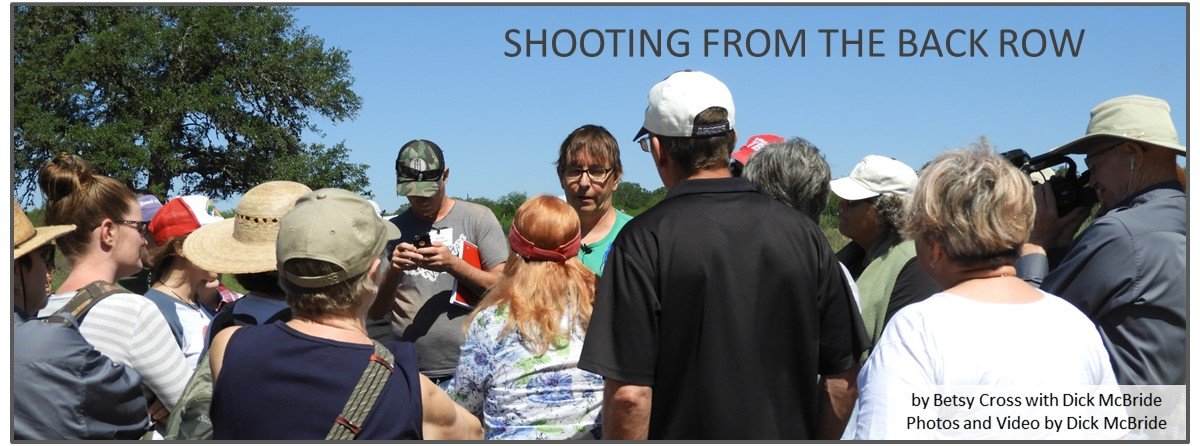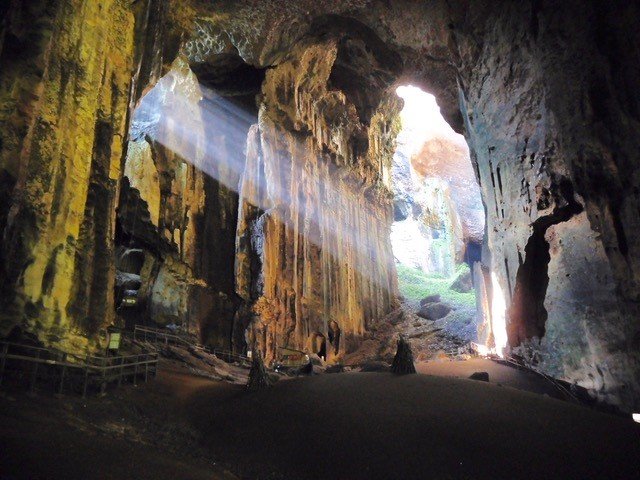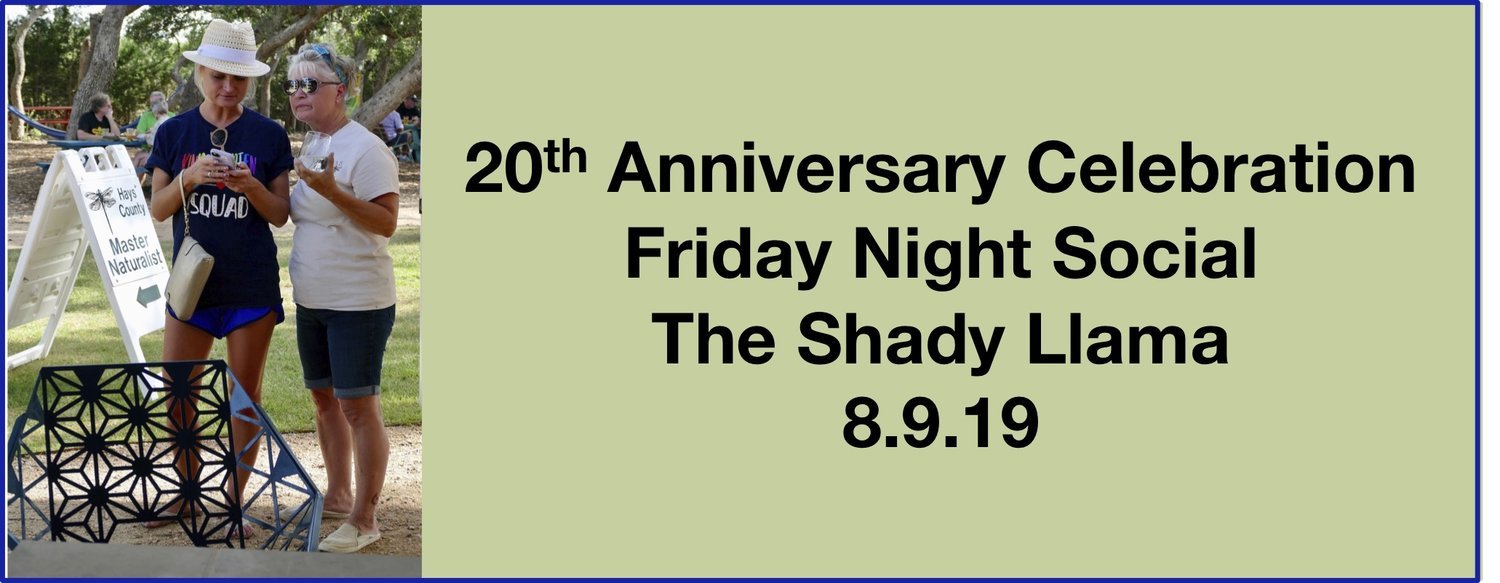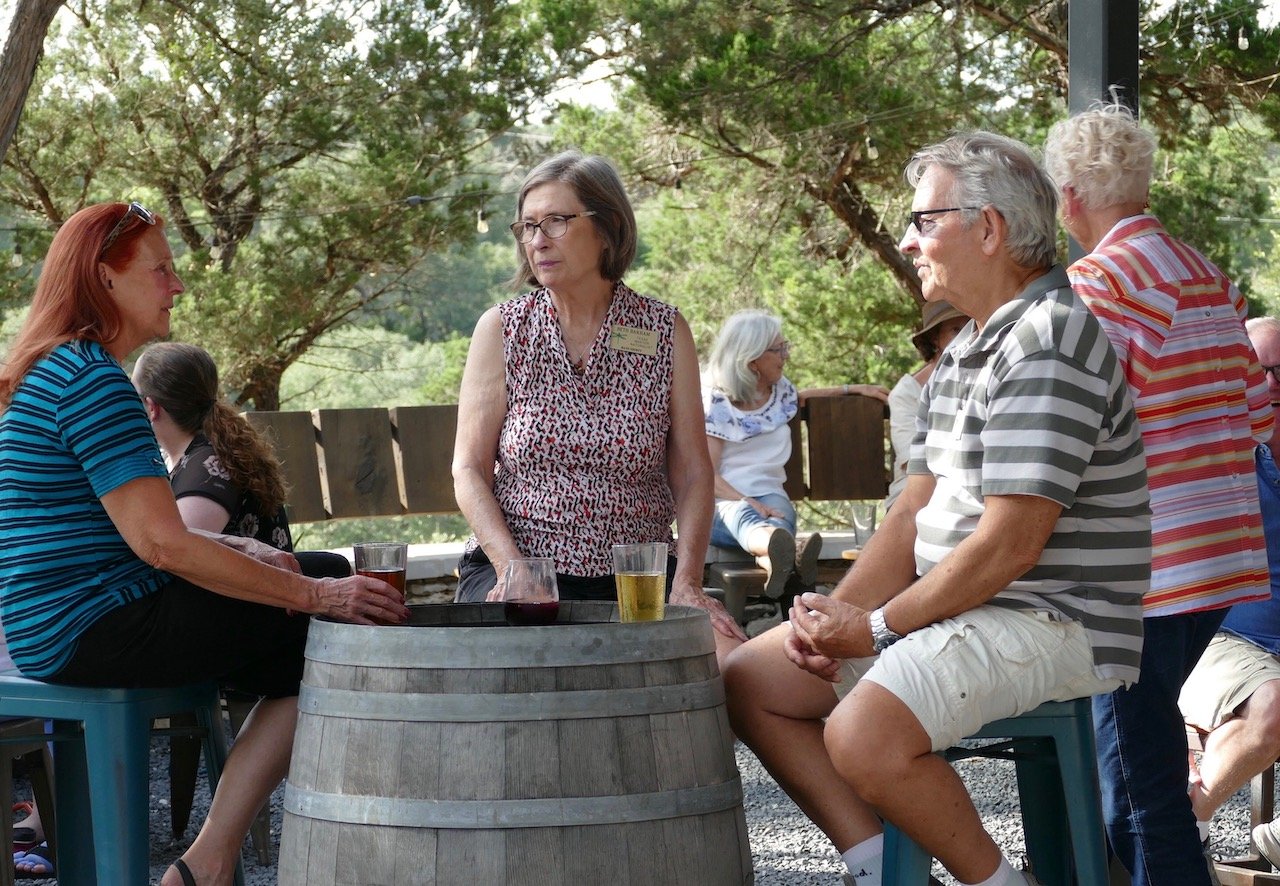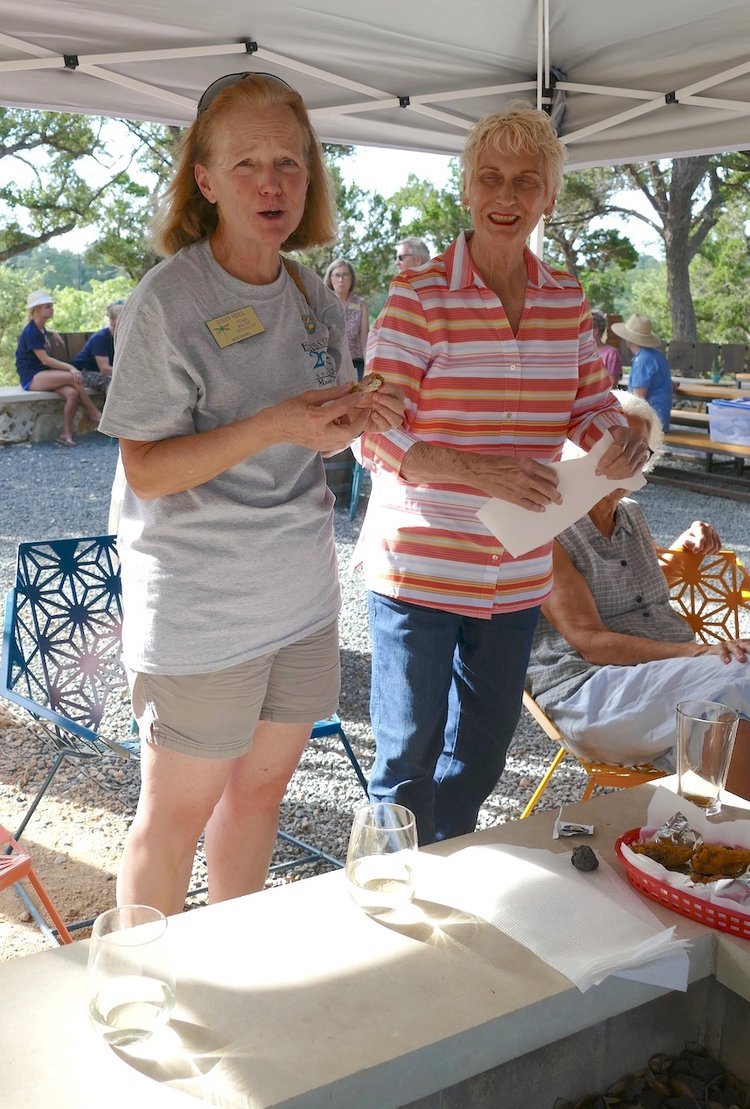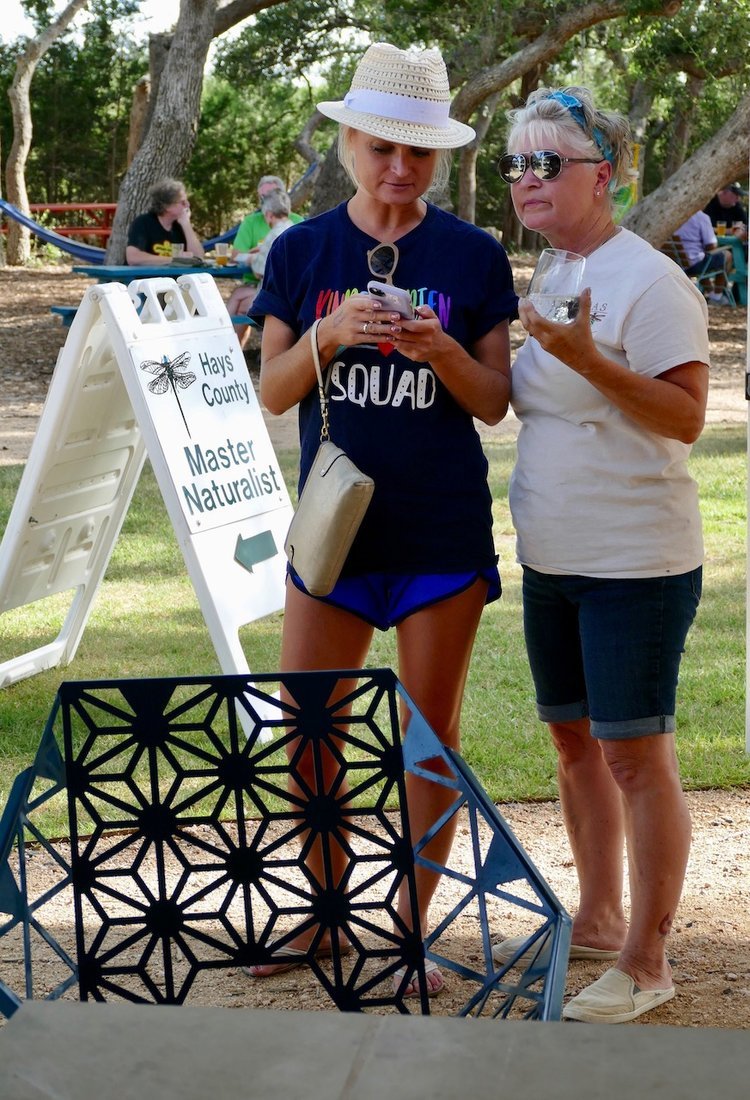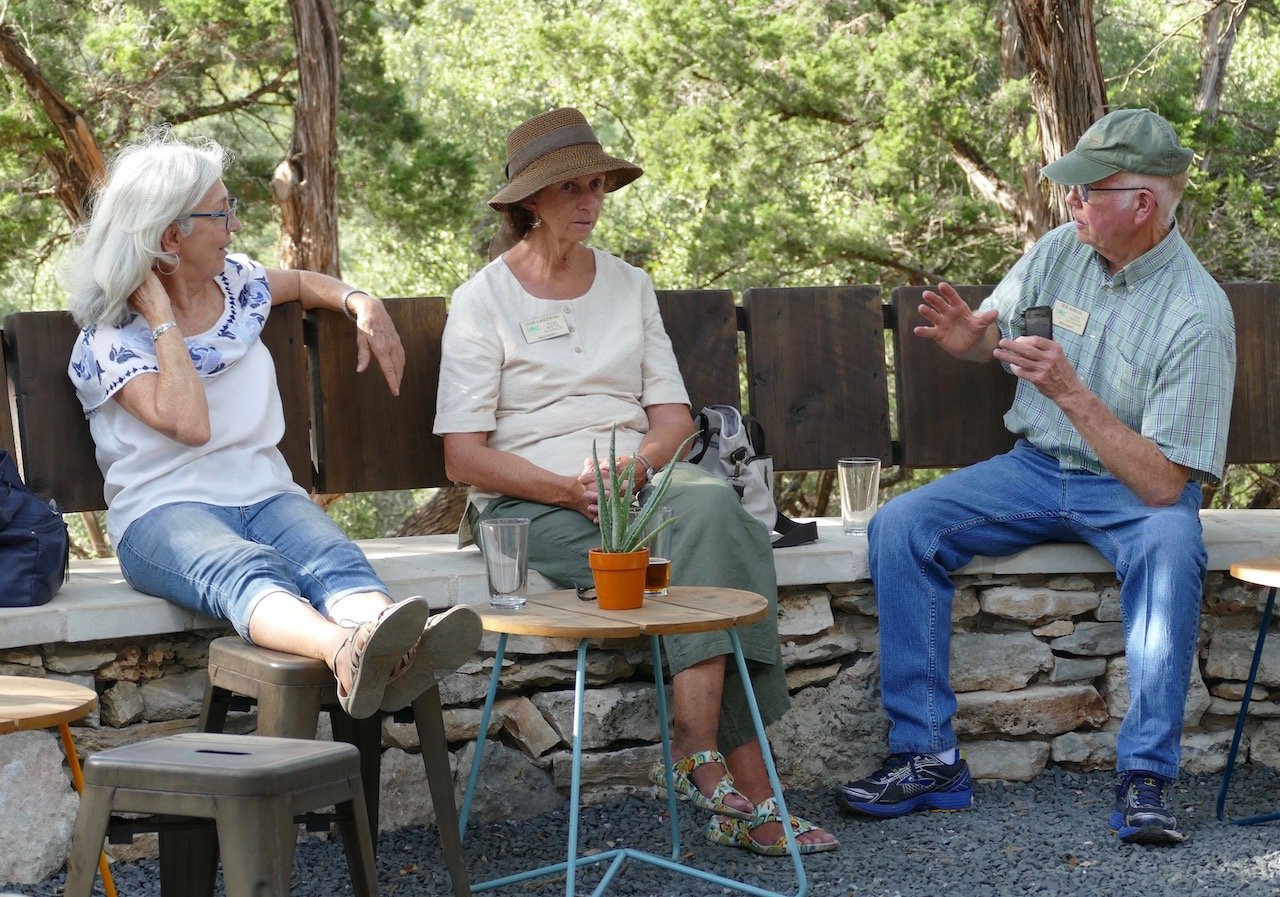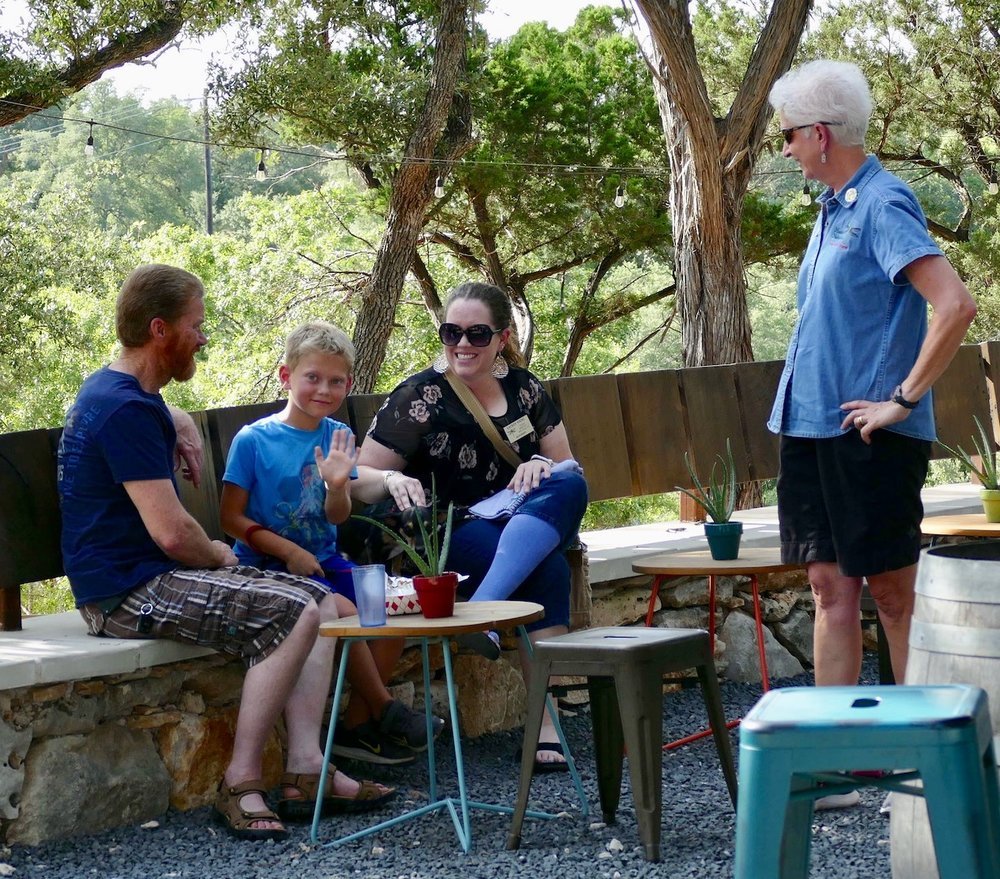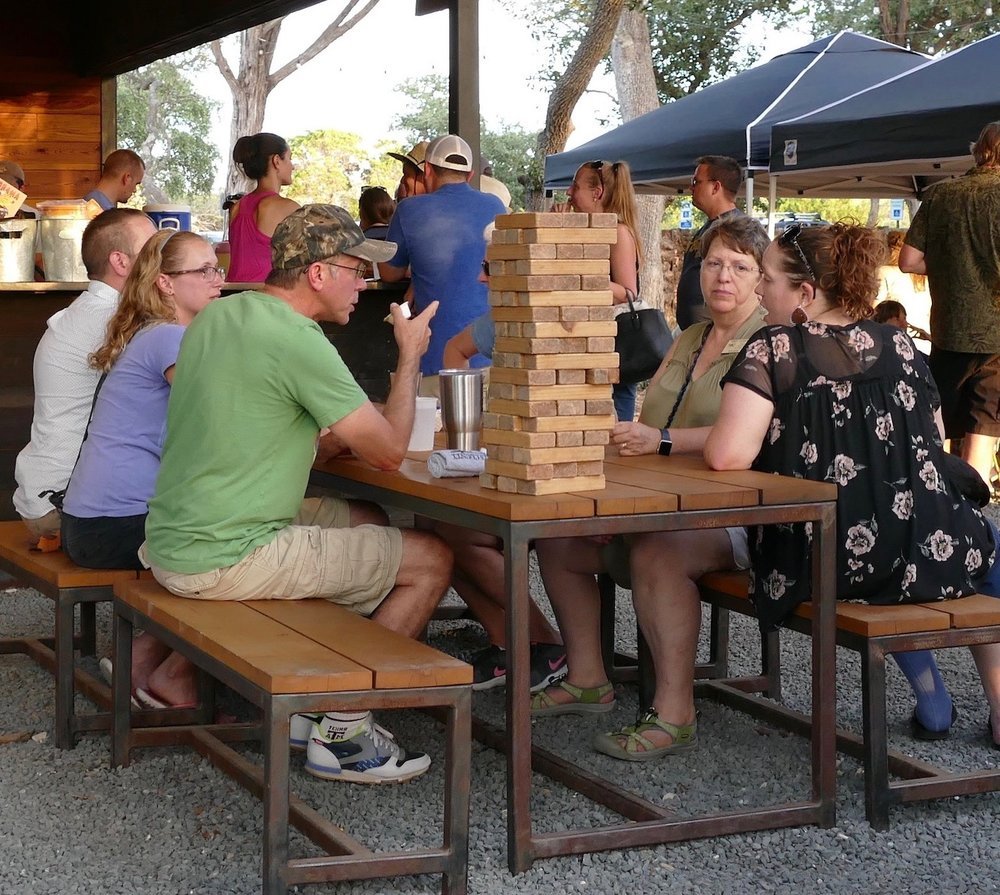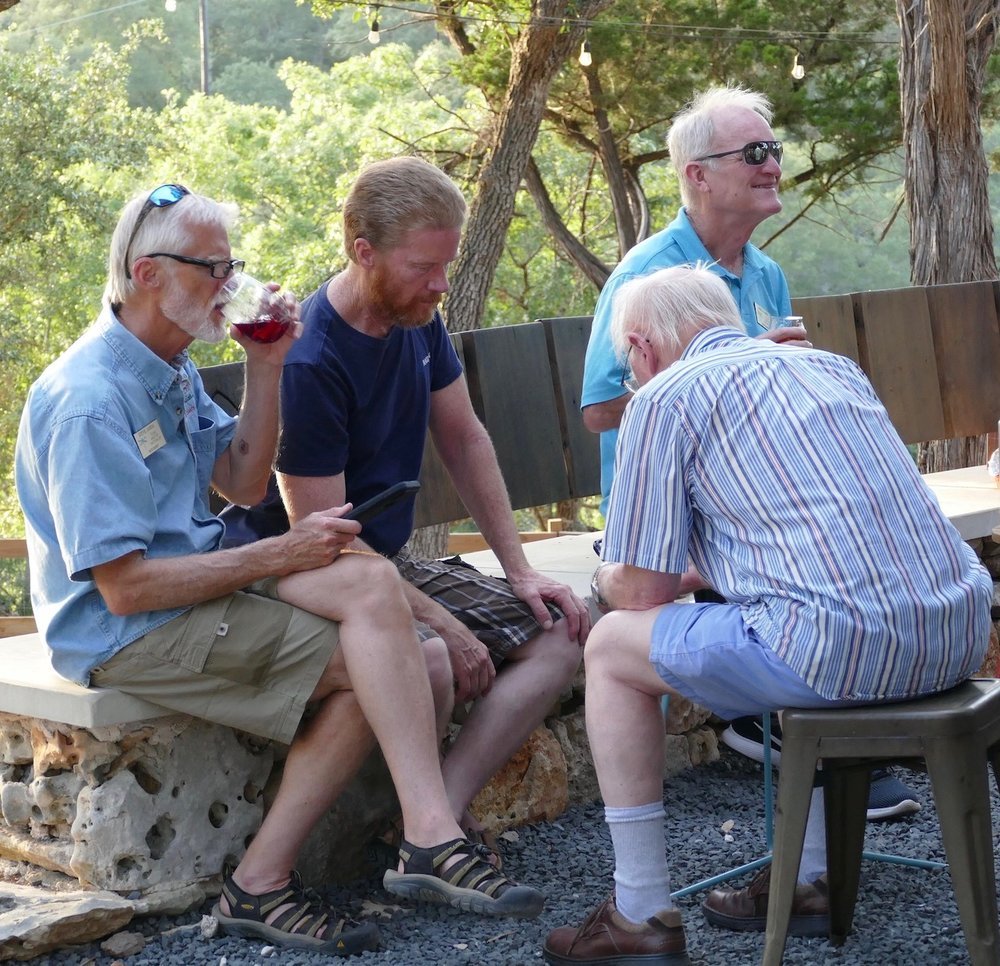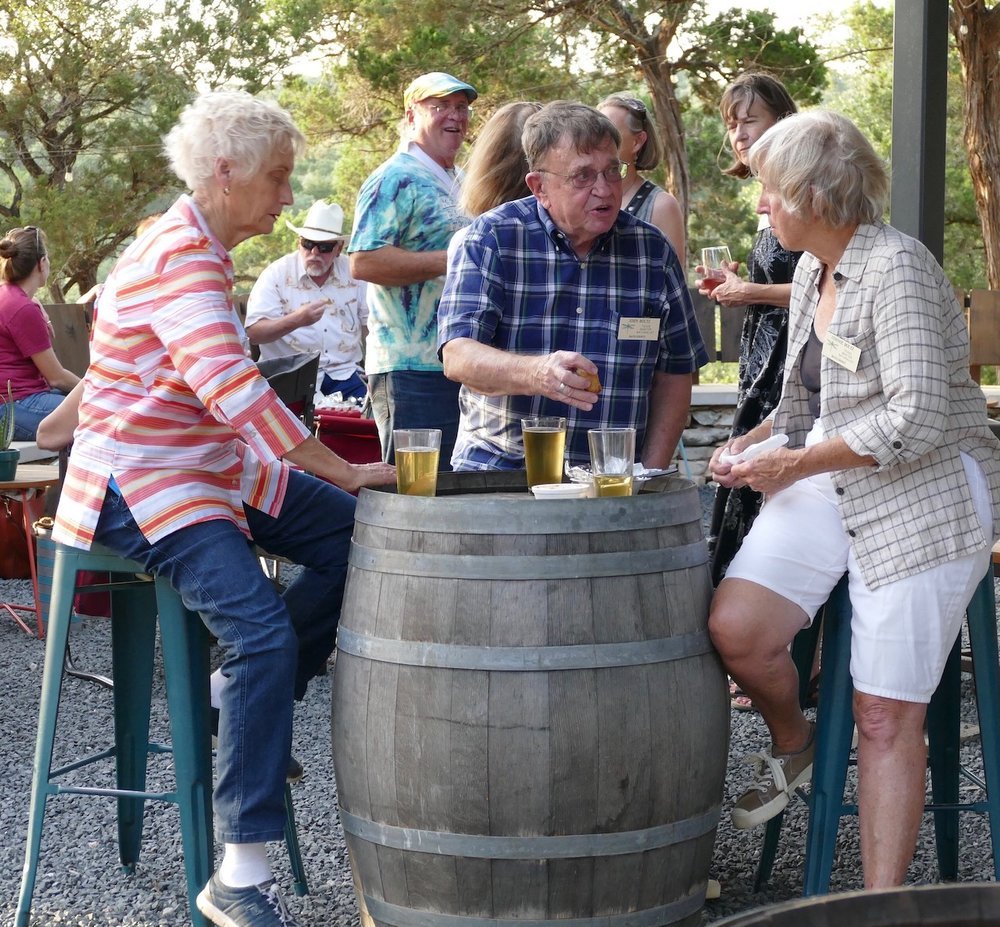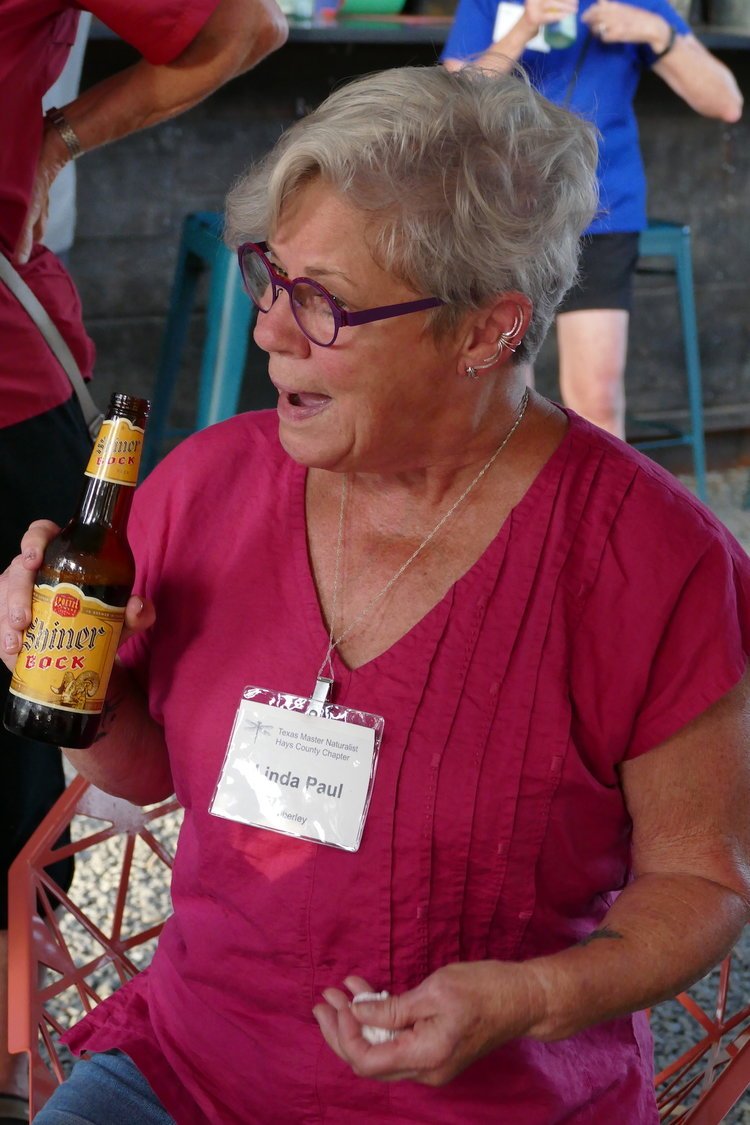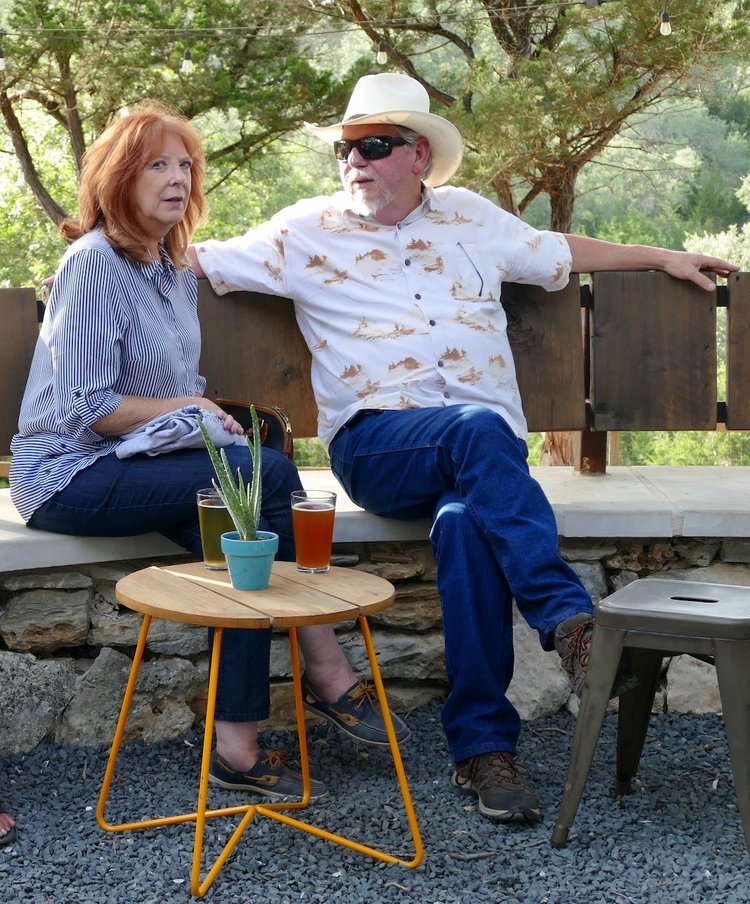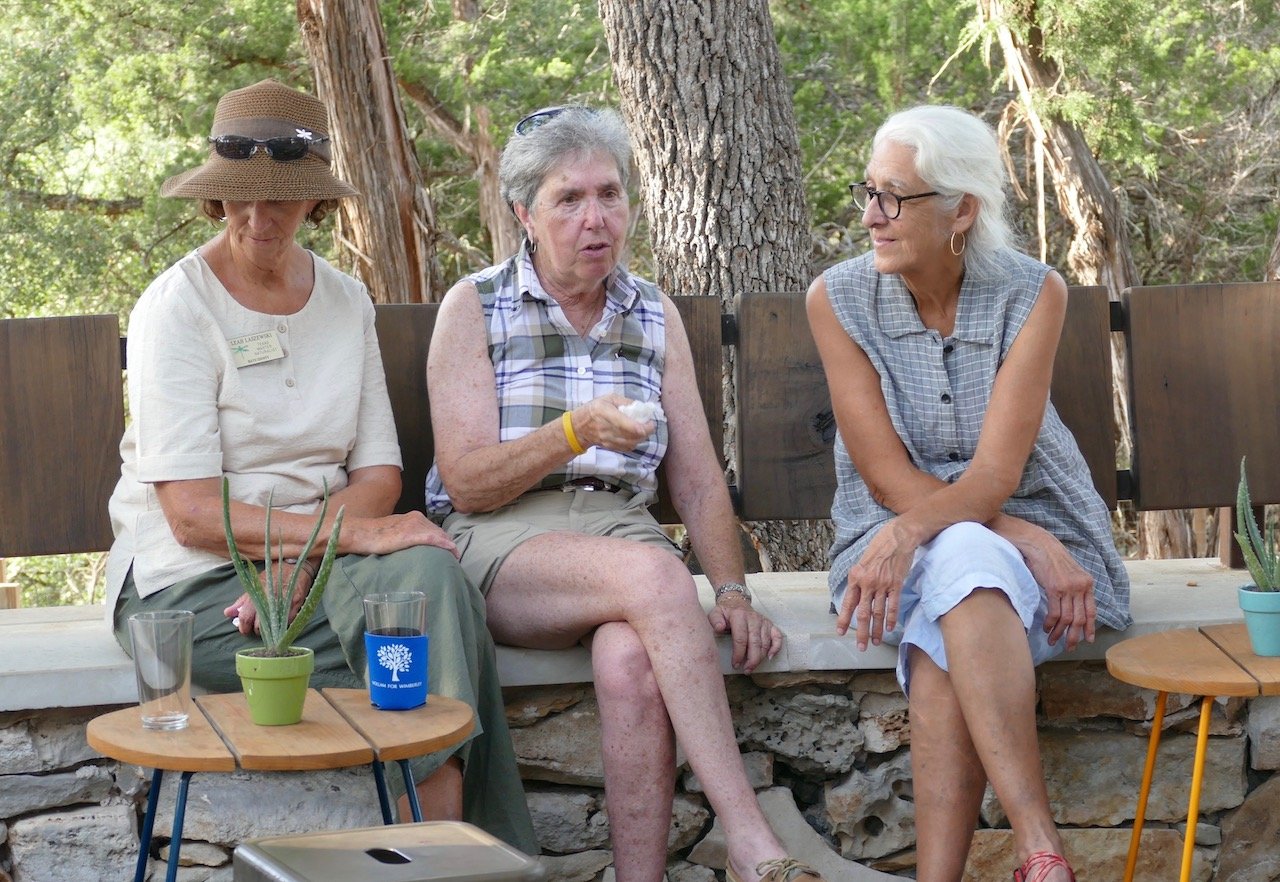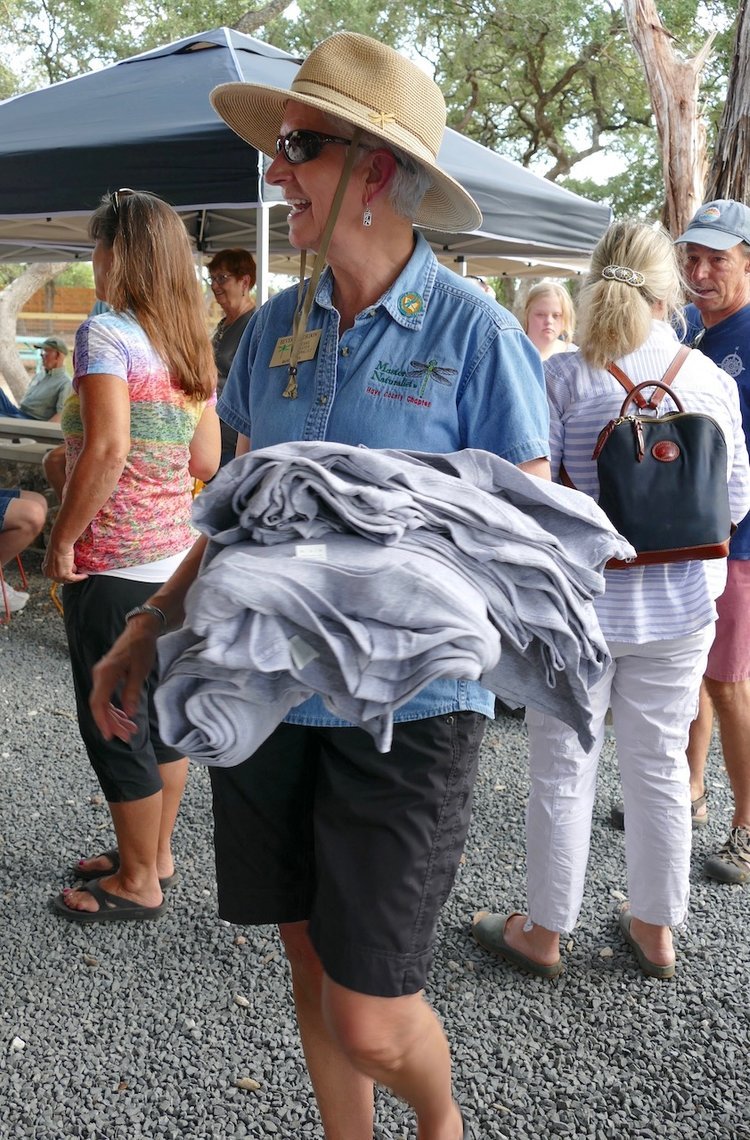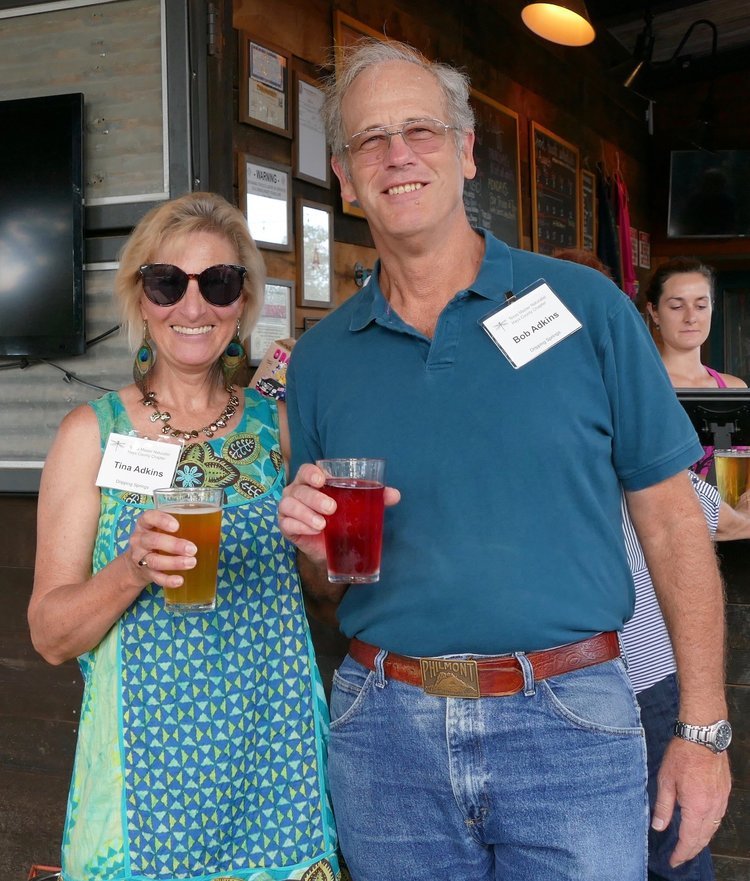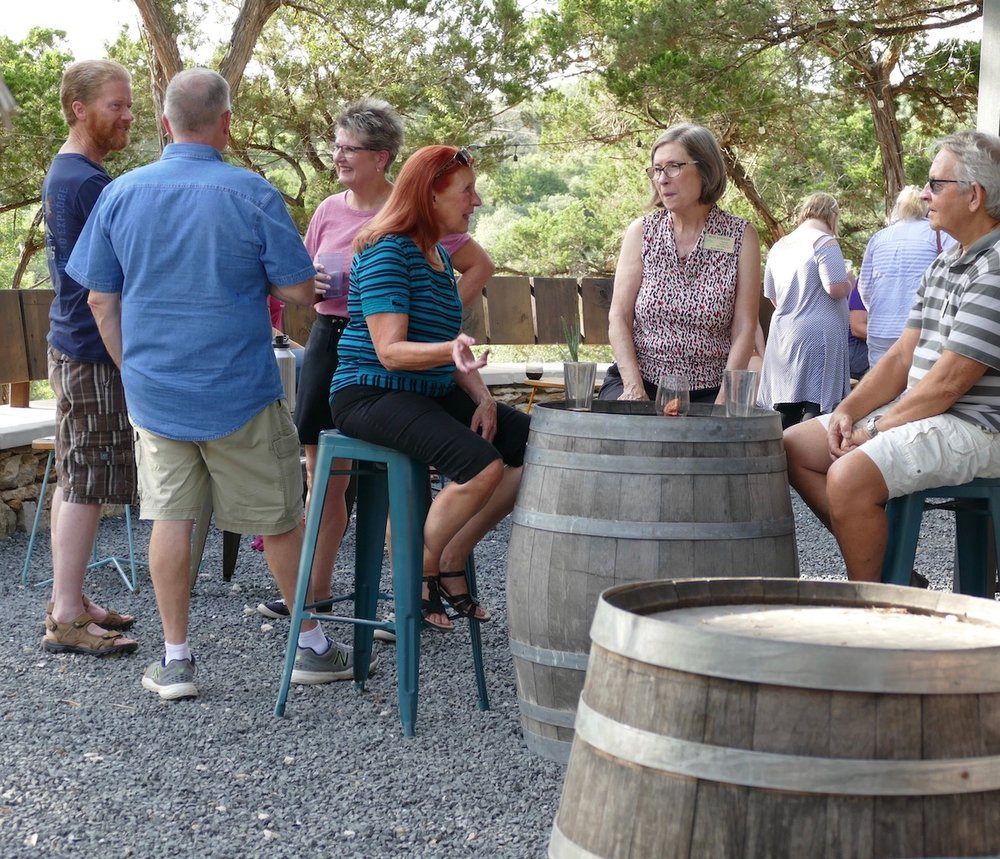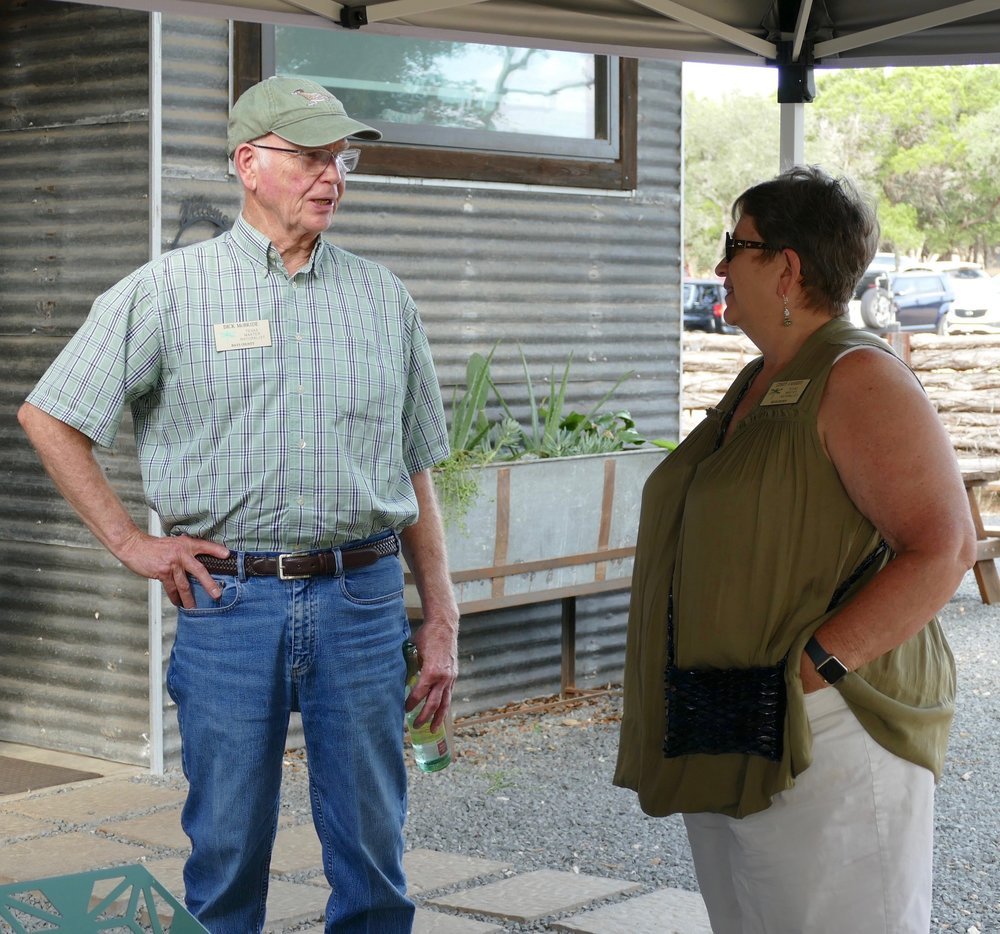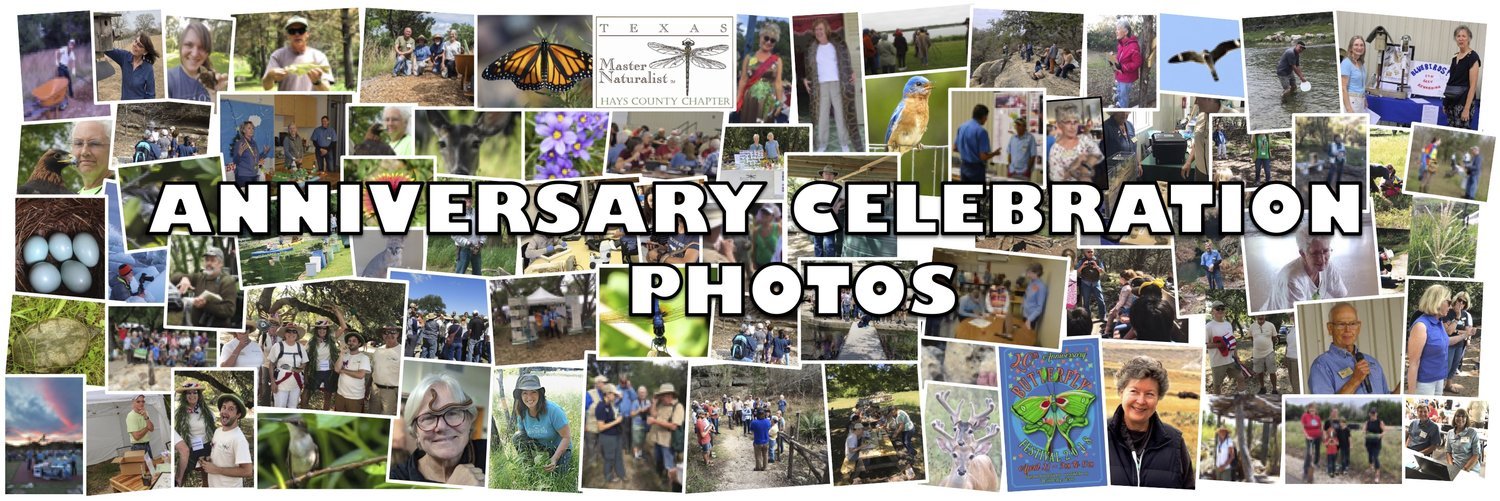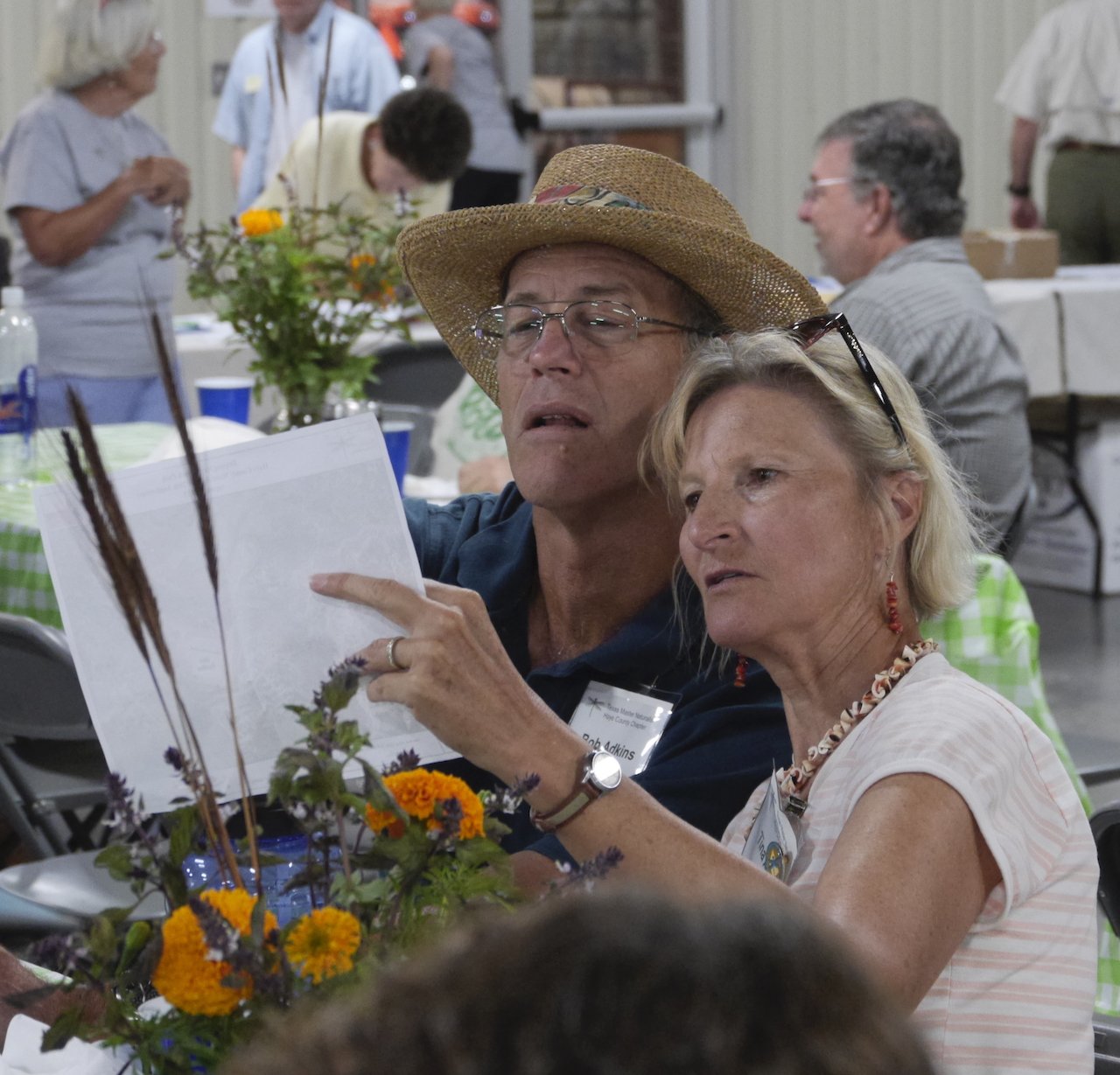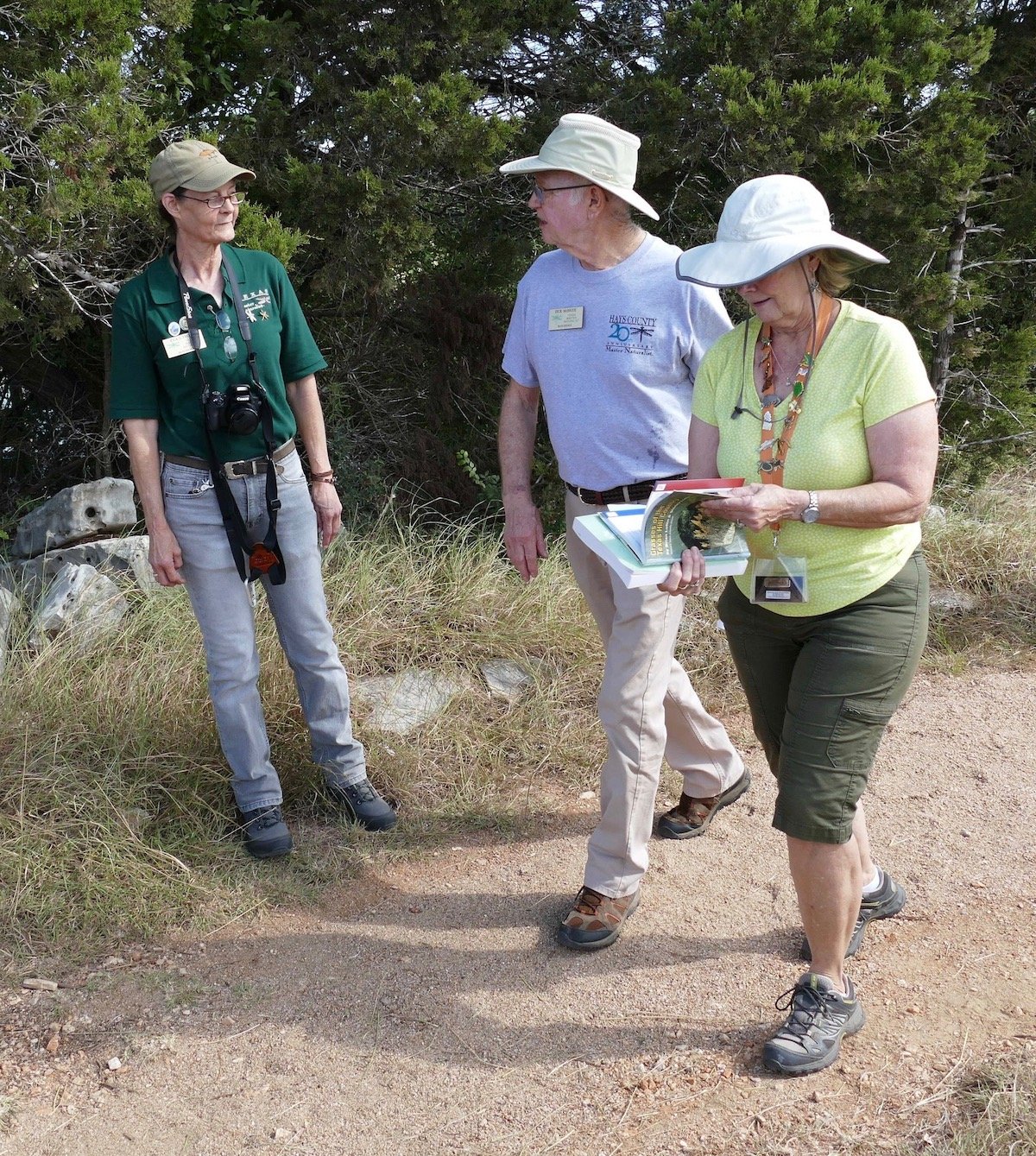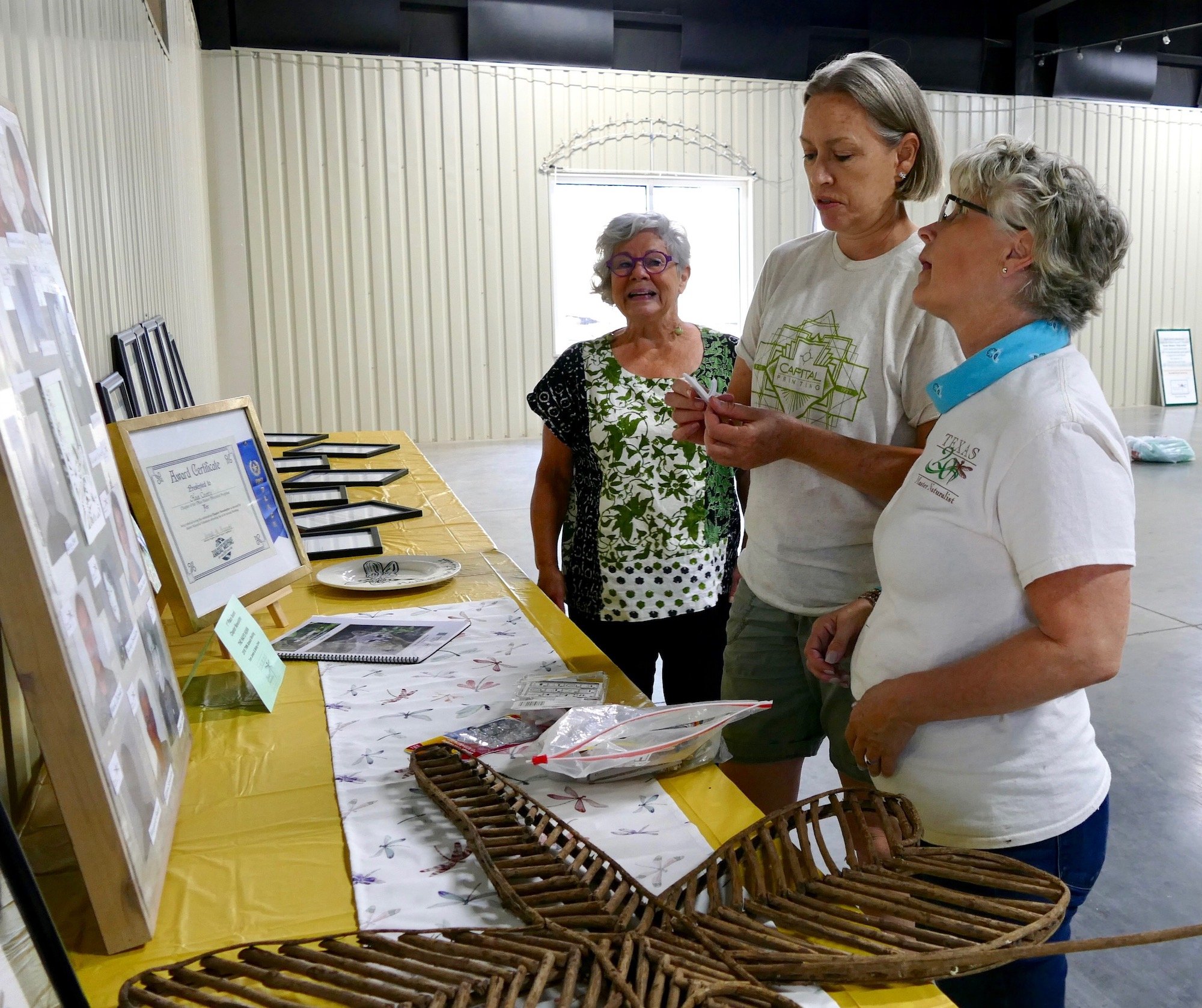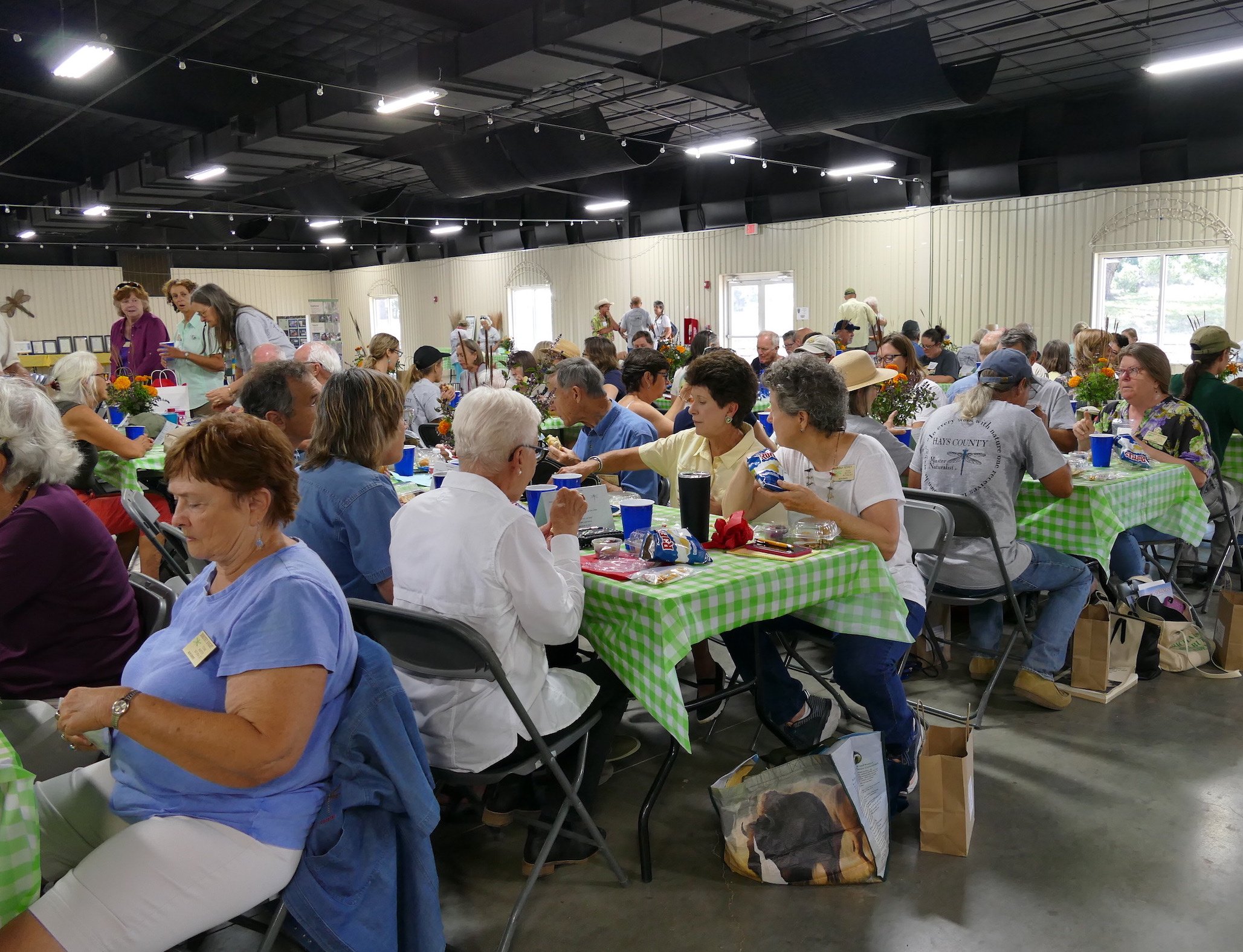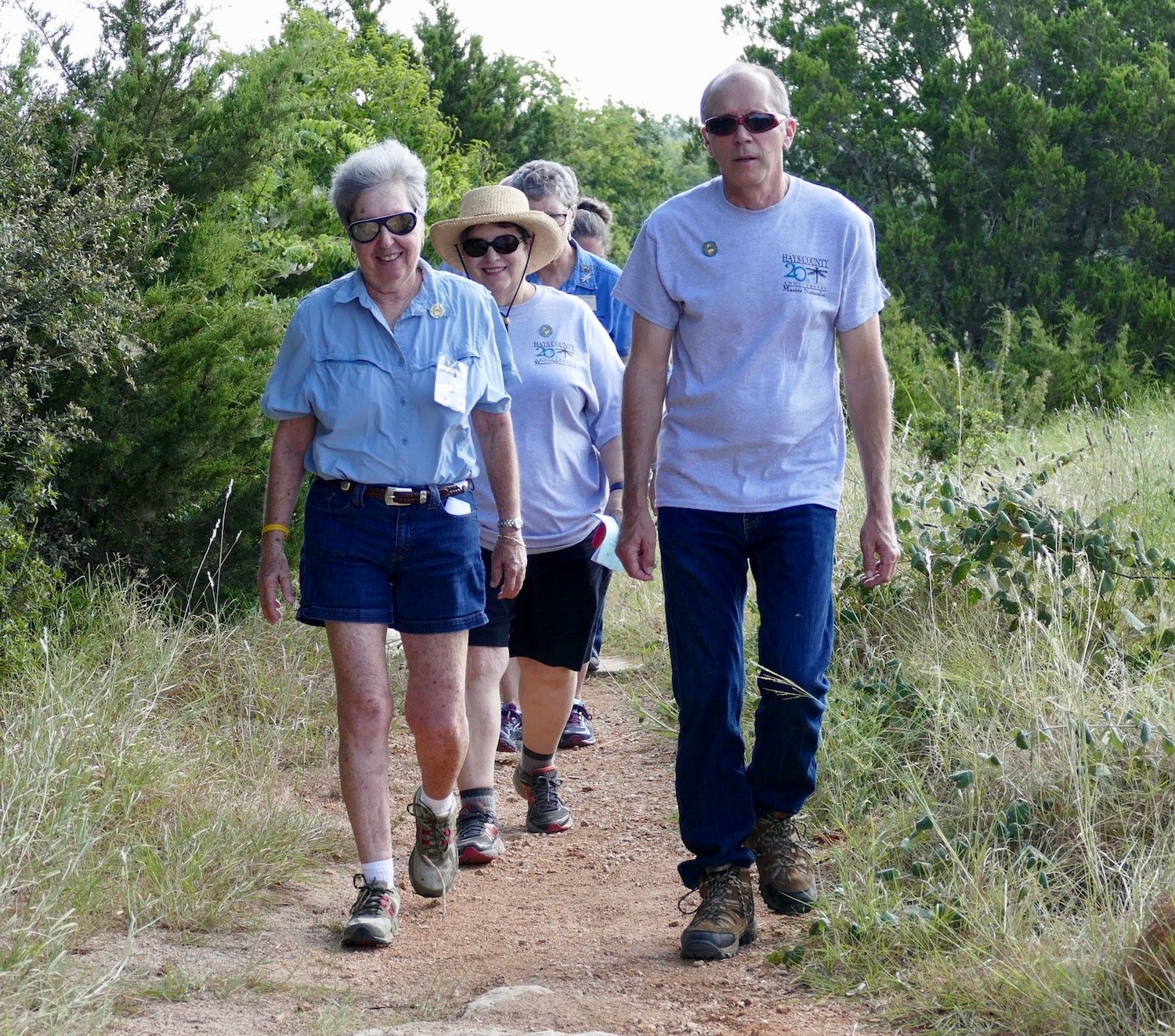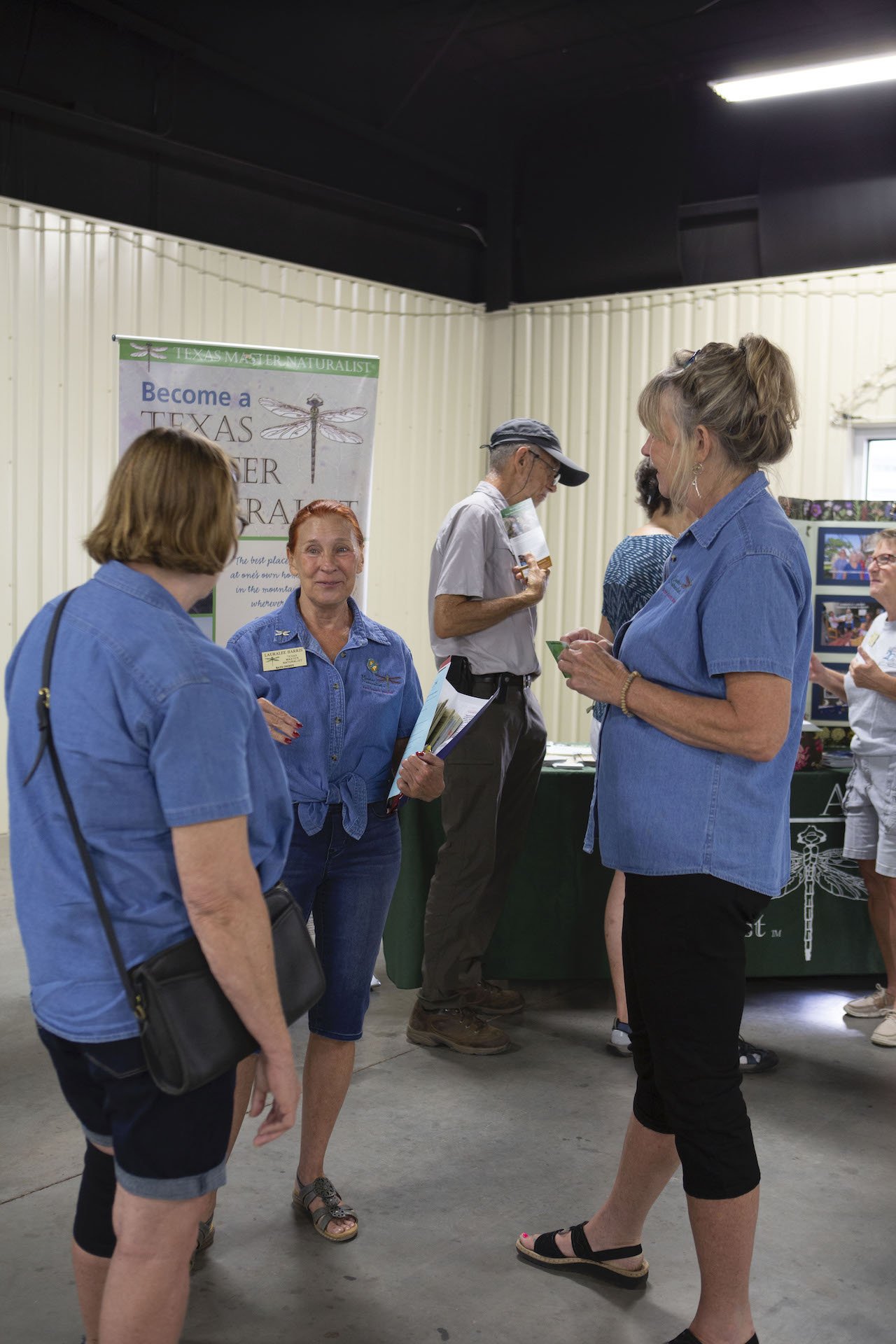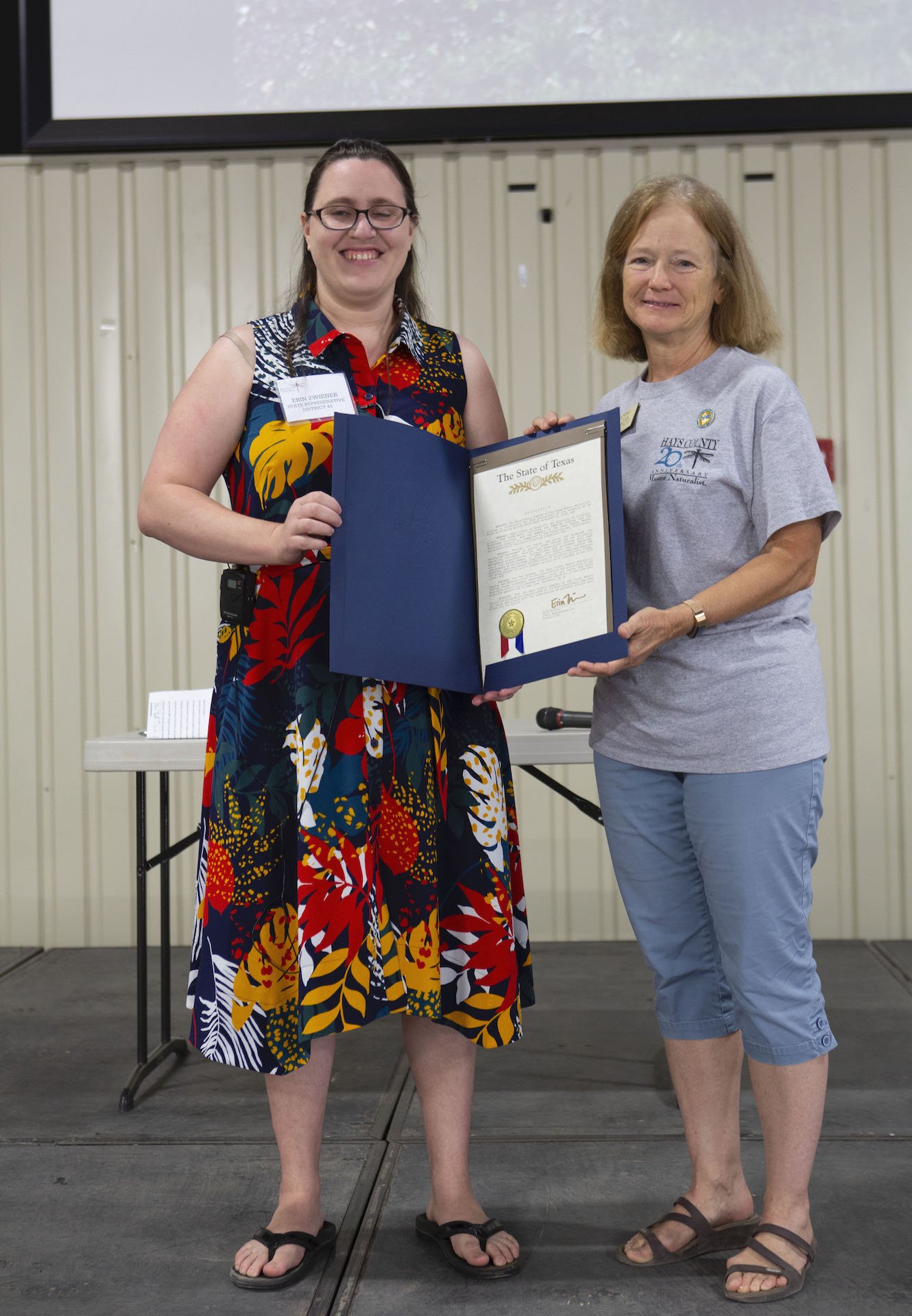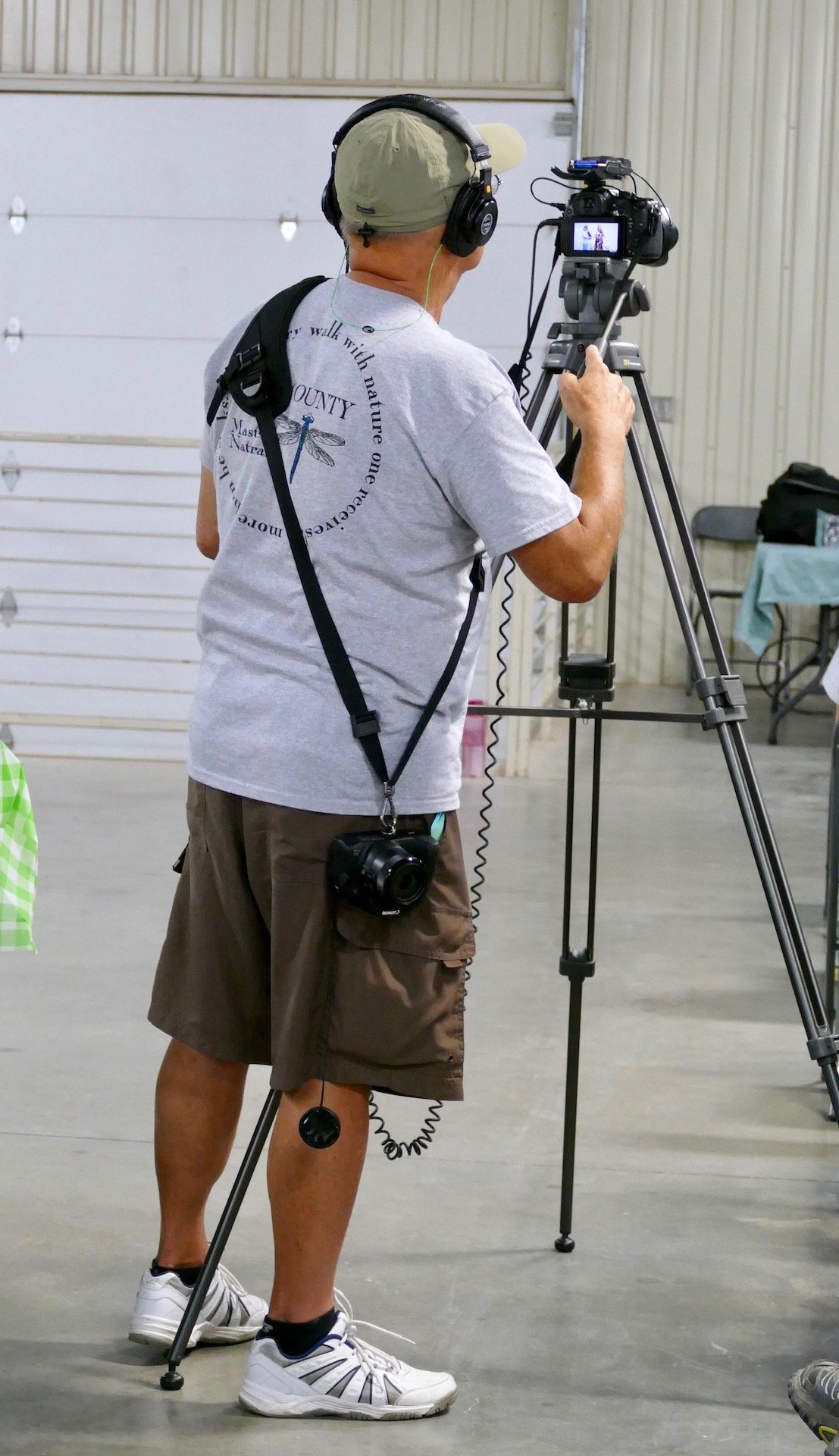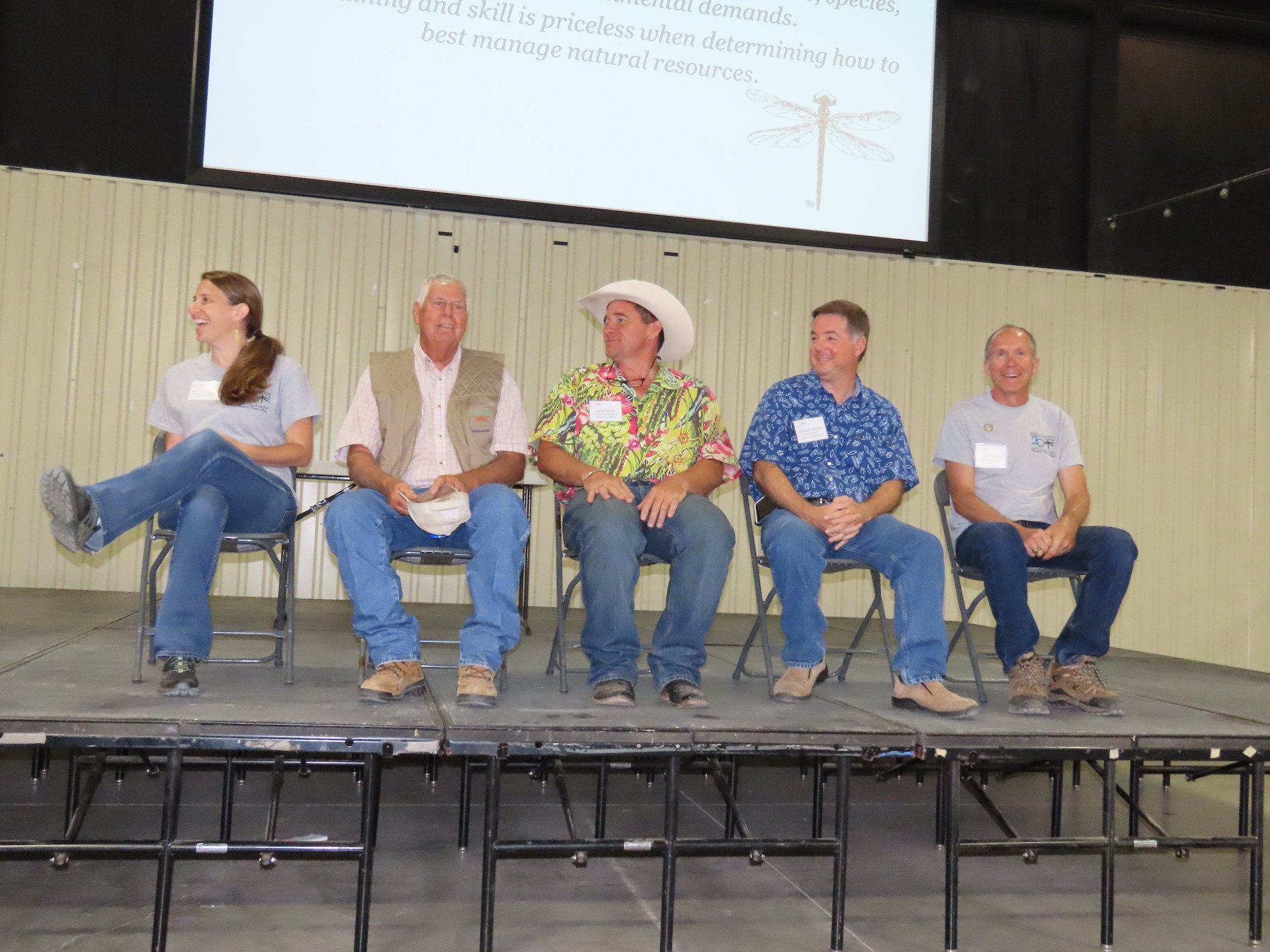The Hays Humm - September 2019
Tom Jones - Betsy Cross - Constance Quigley
Beth and Dick Barham
About Me: I was born and raised in Annapolis, Maryland. I met Dick during my senior year at the University of Maryland and we married within the year. Dick, having been born in Texas, yearned to get back and I was all in for a new adventure. We moved to Temple, Texas in 1973. We have lived up and down I-35 ever since and now live in Dripping Springs. We had two children along the way, both of whom (plus two grandsons) now live in the Austin area. Career-wise, I was Director of Creative and Production for the San Antonio Business Journal. After nineteen years, I decided I’d had enough of DEADLINES. I went back to school and became a Certified Occupational Therapy Assistant. I was hired by University Hospital in San Antonio for their Brain Injury Program. I’m retired now and for several years have been volunteering at the Dripping Springs Community Library and also with RED Arena (horse therapies for individuals with disabilities.)
You May Not Know: Dick and I are avid sailors. We bought our first boat in Annapolis and throughout the 1970s and 80s we teamed up to race small sailboats on many of the Central Texas lakes. We turned to coastal cruising in the mid-90s and kept a boat in Port Aransas for many years. While sailing the Intracoastal Waterway we saw an amazing variety of birds which we couldn’t identify. That’s when we purchased our first field guide. In 2000 our big adventure was crewing in a blue-water sailboat race between Port Aransas and Veracruz, Mexico—12 days down and back.
My Favorite Master Naturalist Activity: This year we helped build the new bird-viewing station at the Dripping Springs Ranch Park. It was a big job which involved many volunteers and generous financial donations. We will be keeping it stocked with birdseed.
Special Birding Moment: It’s migration season. I’m working outside and hear the distant flight calls of passing flocks. I drop everything and search the sky and watch until they disappear.
About Me: I was born in Houston, but as the son of a Foreign Service officer I grew up in Norway, Cyprus, and Greece. Taking a break from college I joined the Army in 1967. After almost a year of training to become an intelligence case officer somewhere in Cold War Europe, the Army assigned me to a combat unit in the Central Highlands of Vietnam. There I recruited a network of Vietnamese informants to provide intel for my unit’s field operations. In two tours of duty with the 173rd Airborne Brigade I was awarded two Bronze Stars but the experience transformed me into a staunch anti-war advocate. Upon returning to college, I was fortunate to meet my future wife, Beth, on a blind date and we will soon celebrate our 49th anniversary. Throughout my 30-year federal career I investigated Social Security and Medicare fraud, followed by a stint with the Texas Attorney General’s office investigating Medicaid fraud.
You May Not Know: As a 19-year-old college student in the summer of 1964, my best buddy and I “crashed” the CIA headquarters in Langley, VA. As we approached the main gate my buddy saluted the guard and he waved us through. I parked my little Fiat sedan near the front door, next to stretch limos belonging to visiting VIPs, and we walked into the building. We wandered the halls, had lunch in the employee cafeteria, and weren’t apprehended until we walked into the personnel office and asked if they had any job vacancies. After an intense debriefing and a stern warning we were escorted off the premises.
My Favorite Master Naturalist Activity: I graduated in 2012 with the Live Oak class. Ever since I have filled and maintained the bird feeders and bird blind at Charro Ranch and have participated in a variety of Wimberley Outdoor Educators programs. I have also greatly enjoyed meeting and getting to know fellow MN members. What a great group of folks.
Bird I Most Identify With: Black Skimmers on the Gulf Coast, because of my fondness for sailing.
Connie & John Boltz
About Me: I’m a retired clinical social worker. My interest in plants and animals goes back to the time I spent in the summers at my grandparents’ summer place in the hills of West Virginia where there was a creek with crawdads and lots to get into outdoors. John and I were in the MN class of 2012 - the Live Oaks.
You May Not Know: I went to grad school in New Orleans and lived on Bourbon Street. That’s where I met and married John, my husband of 53 years. When our kids were young (and we were, too!) we moved to an 80 acre farm in northern Minnesota where we raised cows, pigs, chickens, and vegetables.
Favorite Master Naturalist Project: Everything I’ve gotten involved in has been fun and taught me more about the subject. Since the last project is freshest in my mind it is my current favorite. Taking part in the planning, fund raising and building of the Dripping Springs Ranch Park Bird Station was great. I learned how to use a circular saw and drill. Larry Calvert was a patient project engineer for our aging crew.
Bird I Most Identify With: My favorite bird is the Roadrunner. Every time I see one it’s an omen of good things to come.
About Me: I grew up in northern Minnesota enjoying fishing the many lakes, earning some good money harvesting wild rice as a youngster in late summers, and plotting ways to escape the brutal winters. I then began a nomadic life and met Connie in New Orleans in graduate school. We returned to Minnesota where we began our family. Connie grew a dislike of the bitter cold winters so she joined in my nomadic like of life and we started our journey to the land of Texas via Tennessee, Kentucky, Texas, and South Carolina.
You May Not Know: The town in Minnesota in which I grew up, Frazee, was a village of about 1,000 residents. My father was a great gardener and my mother a wonderful cook. We grew almost everything we ate and there was a locker plant in town where families froze much of the produce raised in gardens. So for many years of our early marriage Connie and I were great gardeners.
Favorite Master Naturalist Activity: The Dripping Springs Ranch Park Birding Station is a unique project which involved leadership, commitment, determination and dedication from HCMNs and the community. I was able to observe Connie make all the phone calls pulling things together and then I’d work with everyone week after week as we poured cement, hammered and drilled and the structure took shape. Wild Birds Unlimited raised funds and promoted the project and folks turned out at a Dripping Springs City Council meeting to raise support. Lotsa folks and fun!
Favorite Bird: My favorite bird is the Red-winged Blackbird. I had a paper route as a kid growing up in Frazee and rode my bike all over town. Wherever I went it seemed there was a Red-winged Blackbird singing to me. When we were building the Dripping Springs Birding Station Red-winged Blackbirds were singing to us.
“In 1994, I traveled to Ireland with a cassette camera and took video on our trip. When I shared it out with the other people on the trip, they loved it. I’ve been shooting video of my travel adventures ever since.”
Dick McBride
If you’ve attended a HCMN class in recent years, chances are Dick McBride was standing quietly in the background shooting video and recording the event. His work to document, process, and post class videos for anyone unable to attend in person contributes significantly to the quality and success of our chapter’s training program.
Dick certified as a Master Naturalist in 2010 with the Prickly Pears. He has a long history with the HCMN Training Team, serving on the Training Committee from 2011-2015 and as Training Coordinator in 2014 and 2015. His primary projects include trail work with the San Marcos Greenbelt Alliance, prairie restoration with the Austin Water Quality Lands, and development of the 31 acres of land acquired by the San Marcos River Foundation. In 2018, Dick received a TMN award for 5000 hours of service.
I recently had the opportunity to sit down with Dick to get some instruction and tips for putting together a nature video. When I asked Dick if he would do an interview for the newsletter as part of the photographer series, he said, “I want to be clear, I don’t consider myself to be a photographer.”
Well…I’ll let you, the readers and the beneficiaries of his work, be the judge of that.
The following is a conversation I had with Dick about his videography. His responses are indented below my questions in bold.
Are there certain areas or types of photography that you tend to concentrate on or specialize in?
I became interested in 35-mm slide photography while I was in the Army in Europe. And in the mid-70s, I started shooting black and white video. For 20 years I shot video of our kids. Then in 1994, I traveled to Ireland with a cassette camera and took video on our trip. When I shared it out with the other people on the trip, they loved it. I’ve been shooting video of my travel adventures ever since.
What are your favorite subjects?
I prefer to shoot travelogues and outdoor nature trips. And then of course, the master naturalist classes provide another kind of opportunity.
Can you share a story about a photography or videography opportunity that was especially exciting or inspiring?
In 2000, I visited Antarctica. It was January, their summer season, and it was light all the time. There were whales and seals and penguins and beautiful sunlit ice.
When you are photographing your favorite subjects, can you describe the camera most often utilized?
My favorite camera is an 8-year old Sony HXR-NX70U Digital Camcorder with a 96 GB hard drive inside the camera.
Do you use other hardware tools when shooting video?
When I’m shooting video in the classroom, I use XLR audio with 2 inputs - the shotgun microphone on the camera, and the presenter gets a mic, too. The only time I use a tripod is in the classroom; otherwise, I am hand-holding the camera with the in-camera mic.
What software tools do you use?
Vimeo PRO, at $200/year, provides a platform for posting videos. Vimeo is a small community of professionals, with no advertisements, and allows you to password-protect your shared videos.
Adobe PremierPro is a full-service video editing studio that can be leased as a stand-alone software for $21/month or as part of a larger suite of Adobe photographic editing tools.
Sonicfire Pro 6 from SmartSound is the source of music I’ve used for 15 years now. It automatically synchronizes with the rhythm and transitions in the video and can easily be added in and overlaid onto video tracks.
Can you describe how you manage and process your videos?
Creating the Video Components: I rarely edit files on my camera because it’s time consuming. Instead, I dump all the files onto my computer. Let’s say I bring in 50 files, some around 40 seconds or so. I start looking at them one at a time and put them into a timeline, creating a folder for Day 1 files, and so on.
Utilizing Adobe PremierPro: I move the files into a library in PremierPro. I want my video to move quickly, so within the video editing program, I start to cut down the time of the scenes. In the end, I may take 15 hours of video and condense it into a 1-hour composite. After the first edit, I add titles, transitions, and externally created material such as the music. I often use Apple’s “Motion” program to create maps with moving lines showing where we are/were traveling. Then I do the voice-over, sometimes using a script I’ve written, but most often just ad-libbing my commentary.
Utilizing Sonicfire Pro 6: Picking from the Sonicfire music portfolio, I select different tracks of music that emphasize the mood of the scenes.
Finalizing in PremierPro: I import the music file (AIFF) into PremierPro and polish the video for final publishing.
Uploading to Vimeo: The final step is to publish the video and share the password to users.
Dick took a series of videos of a pair of foxes and their two frisky kits in his backyard this year.
Utilizing the software tools and steps outlined above, he walked me through the process of creating a short video story.
Here’s how it turned out.
What are your top three videography tips for us newbies?
Get Started!
Apple has iMovie and Windows has a free video editing program that is pretty simple for beginners.
There are online classes to help, also. I subscribe to a weekly live webinar by Larry Jordan to improve video skills
Dick shared these additional wonderful photos from his travels. His dedication to the quality and success of our chapter’s program and to his fellow travelers is felt throughout Hays County and beyond.
Unloading equipment and safety gear
I first learned about the Austin Wildlands Cave Dig when Bruce Cannon (2019 TX Horned Toads) dropped me an email about a unique volunteer opportunity. Bruce knew I was interested in karst formations and the Project involved entering the Edwards Aquifer recharge caves on Onion Creek. I signed up and arrived at the designated work site in the Onion Creek Watershed near Dahlstrom Nature Preserve on August 4.
This is how I met Audrey Stewart, Austin Wildlands Volunteer Coordinator. She was leading the Cave Dig with Water Quality Protection Lands biologist Devin Grobert. Typical work projects managed by Austin Wildlands are associated with conservation and preservation efforts for this and many other Hill Country properties. The work this morning involved digging out accumulated sediments from the cave entrances to improve water entry, resulting in increased recharge to the Edwards Aquifer.
Once we reached Onion Creek, it was time to distribute the protective gear required for the work. This included helmet, gloves and knee pads along with the required work tools. Onion Creek has many Karst related features, including caves and sinkholes. Surface water flows into these large holes resulting in direct recharge to the underlying Edwards aquifer.
We divided into teams, each team working a different cave. The first activity involved removing the large covers from the caves to allow entry. The covers are required to prevent access by humans and animals. It also controls sediment and gravel entry into the cave while allowing water to flow into the subsurface. One person enters the cave, digs out gravel and sediments filling buckets and bags. The photos illustrate the tight work space environment. The sediment was then transported out of the creek bed to the adjacent riparian areas. This allows the debris to be dumped several hundred feet away from the cave entrances. The work was simple, but the task difficult due to the restricted space within the cave and the physical effort required to haul the heavy bags out of the creek. Also, in August the heat is always a factor.
The City of Austin Wildland Conservation Division manages over 40,000 acres of conservation lands in Hays and Travis Counties. About 28,000 of those acres are part of the Water Quality Protection Lands program whose goal is to protect the quality and quantity of local groundwater and maintain the flow to the iconic Barton Springs. Approximately 60% of the Water Quality Protection Lands are privately-owned conservation easements.
View of the Edwards Aquifer Recharge Zone
Numerous caves and sinkholes along Onion Creek. All are covered with screens to allow water entry while excluding animals, humans and gravel.
Working In the Cave, digging out accumulated gravel and sediment
Moving the sediment and gravel from the cave
Tom working the bucket brigade. Transporting cave fill to the riparian areas next to the creek. During the work activity an estimated 35-40 buckets were removed.
As I head home, I am exhausted, dirty and soaked with sweat. I am happy to have participated and gained a better understanding of how the karst systems in the Hill Country work and the importance of protecting open spaces. The efforts by Audrey Stewart and the Austin Wildland’s team are making a difference in Hays and Travis counties. I am glad to have participated and hope to do future projects with them.
Audrey Stewart - (photo by Lance Jones)
About Audrey Stewart: I am the volunteer coordinator for both the BCP and WQPL programs. I coordinate volunteer workdays on the conservation lands that are led by trained volunteer leaders and program staff. On my favorite days, I get to be out with our awesome volunteers leading guided hikes for the public or working on ecological restoration projects.
Favorite Conservation Activity: My favorite activity right now is collecting ripe seeds from native grassland species on Water Quality Protection Lands with volunteers to later spread on parts of the land that need more cover and diversity. It’s a fun and relaxing activity where you learn some plant ID and chat with folks or wander off a little bit away from the group to get some quality me time in nature. It’s also satisfying because it makes a big impact on restoration. Last year, of the 110 species of native seed spread on the WQPL, 13 species were bought commercially and 95 other species were harvested by volunteers and staff directly from the WQPL lands themselves.
AUSTIN WATER’S WILDLAND CONSERVATION DIVISION
Austin Water’s Wildland Conservation Division manages conservation lands in Travis and Hays counties. These lands fall under two programs with different missions and different land management practices: The Balcones Canyonlands Preserve (BCP) and The Water Quality Protection Lands (WQPL). The mission of the WQPL, which includes >28,000 acres of land in Hays and Travis counties, is to acquire and manage land to help produce the optimal level of clean, high-quality water to recharge the Barton Springs segment of the Edwards Aquifer. We mainly restore the WQPL lands to native grassland and savanna using techniques like prescribed fire and through volunteer stewardship activities, including collecting and spreading native seeds, removing invasive species, and hauling debris from caves. The BCP about a ~32,000 acre system of preserves that protects and mitigates for habitat loss for two neotropical migratory songbirds (Golden-cheeked Warbler (federally endangered) and Black-capped Vireo (recently delisted)), six karst invertebrates, and 27 species of concern in western Travis County. We mainly restore the BCP to closed-canopy Ashe juniper-oak woodlands through a variety of efforts, including restoring soils, planting native plants, and removing invasives. We also work to restore cave habitats and monitor endangered and rare species on the BCP.
Read Audrey’s testimonial letter to the HCMN on their 20th Anniversary. Click Here
EmilyAnn Theatre and Gardens
A look back
Article submitted by Mary Dow Ross
Hays County Master Naturalist, Karen Hulene Bartell, had the idea that the HCMN chapter could assist the EmilyAnn Theatre with their Cages for Classrooms. In a memo dated April 6, 2006, she reported to Ann Rolling, co-founder of the theatre, that she had received approval and was waiting for a project number to be assigned. The photo on the left, found at the EmilyAnn Theatre last year when they were celebrating their own 20th anniversary, was taken in late March or early April of 2009, three years after the two organizations began working together. By that time the caterpillar count had moved from an initial 36 caterpillars in 1999 to 2000 caterpillars and 74 cages, along with 15 monarchs and 4 swallowtails. This March that number was 4000 caterpillars and 228 cages, all prepared and delivered to schools, businesses and individuals by Hays County Master Naturalists. The picture was taken in front of the Wild Stuff Gift Shop of the Wild Connections Butterfly Farm that was located off Nutty Brown Road in Dripping Springs. That location provided more room for the cage preparation. And what do those nifty bandanas say...why "I'm a Worm Wrangler" of course!
Bluebird nest boxes were installed and monitored as part of the HCMN Dripping Springs Ranch Park (DSRP) project. Bonnie Tull developed the bluebird trail aspect of the project and created the unique design for the six bluebird boxes.
Bonnie refers to her nest box design as the “Forever Box”, because it is constructed out of PVC fence post scrap with stainless steel hardware. Unlike wooden nest boxes, the PVC boxes retain their integrity over the long haul. Their white color reflects the sun and heat, they are impenetrable to woodpecker activity, and they have an additional exit hole in the back for adult bluebirds to escape from invasive birds. Bonnie’s nest box plans, instructions, and monitoring tips may be accessed here.
The DSRP project team installed the boxes across the property in ideal bluebird habitat. Bob and Tina Adkins monitored and documented nest box activity.


